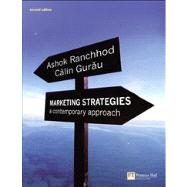
| From structure to chaos? | |
| Understanding marketing strategy | |
| Introduction | |
| Technological advances | |
| The marketing concept | |
| Marketing as a business process | |
| The role of market orientation | |
| Strategic planning to deliver the marketing concept | |
| Environmental factors | |
| Creating a sense of identity | |
| Time as an issue in planning | |
| Ethics as a marketing issue | |
| Towards a new strategic marketing planning model | |
| Summary | |
| Chapter questions | |
| Opening up analysis and positioning | |
| Introduction | |
| Internal analysis | |
| External analysis | |
| Key issues to consider when using portfolio matrices | |
| The marketing information system | |
| Market segmentation | |
| Strategic positioning | |
| The Internet, postmodern marketing and globalisation | |
| Summary | |
| Chapter questions | |
| Stakeholder concerns and solutions | |
| Introduction | |
| Stakeholder theory | |
| Developing competitive marketing strategies | |
| Summary | |
| Chapter questions | |
| A sustainable Earth matters | |
| Introduction | |
| Understanding environmental marketing | |
| Implications for organisations | |
| Green consumer behaviour | |
| Green marketing strategies | |
| Summary | |
| Chapter questions | |
| Communicating effectively | |
| Introduction | |
| Corporate image and corporate identity | |
| Defining the IMC concept | |
| Organisational challenges to implementing the IMC concept | |
| Implementing the IMC concept | |
| IMC in an online environment | |
| Brands | |
| Summary | |
| Chapter questions | |
| Implementation is the key | |
| Introduction | |
| Planned versus emergent implementation | |
| The main factors influencing strategy implementation | |
| The impact of technology on marketing implementation | |
| Customer relationships | |
| Summary | |
| Chapter questions | |
| Understanding and creating effective marketing cultures | |
| Introduction | |
| The visible and invisible parts of an organisation | |
| The transition from focusing on products to a customer orientation | |
| The learning organisation | |
| Keeping the benefits of a learning orientation | |
| Summary | |
| Chapter questions | |
| Globalising marketing efforts | |
| Introduction | |
| The main factors influencing international marketing operations | |
| Offshoring and globalisation of suppliers | |
| International marketing orientations | |
| Standardisation versus adaptation | |
| Selecting which foreign markets to target | |
| Marketing entry strategies | |
| Managing international operations | |
| Summary | |
| Chapter questions | |
| Measuring for effectiveness in marketing | |
| Introduction | |
| Measuring marketing performance | |
| The role of financial analysis | |
| Profit ratios Liquidity ratios | |
| Leverage ratios | |
| Activity ratios | |
| Marketing metrics | |
| Understanding measurement within the global context | |
| Measuring environmental effectiveness | |
| Developing individual measures | |
| Summary | |
| Chapter questions | |
| New perspectives in marketing and the way forward | |
| Introduction | |
| Moving away form the 4 Ps | |
| Consumer behaviour | |
| Value cocreation | |
| The dynamic environment | |
| Digital marketing | |
| Social marketing Rural marketing | |
| Towards a strategic marketing model | |
| Summary and final observations | |
| Chapter questions | |
| References and further reading | |
| Index | |
| Table of Contents provided by Publisher. All Rights Reserved. |
The New copy of this book will include any supplemental materials advertised. Please check the title of the book to determine if it should include any access cards, study guides, lab manuals, CDs, etc.
The Used, Rental and eBook copies of this book are not guaranteed to include any supplemental materials. Typically, only the book itself is included. This is true even if the title states it includes any access cards, study guides, lab manuals, CDs, etc.